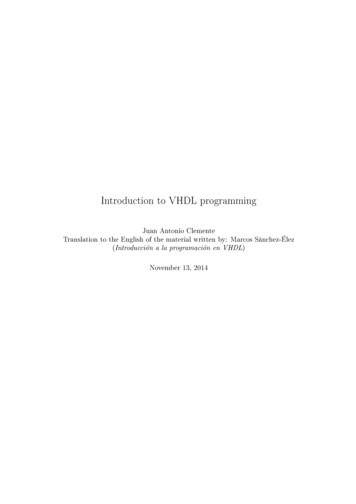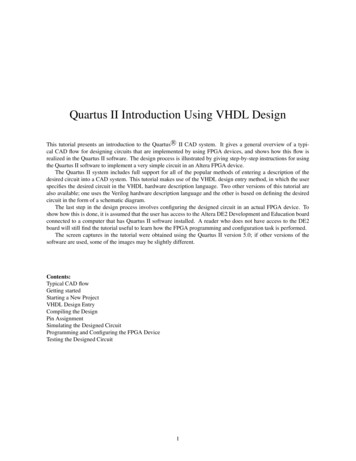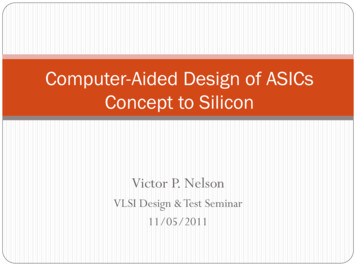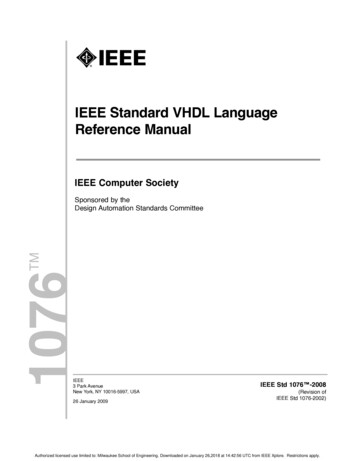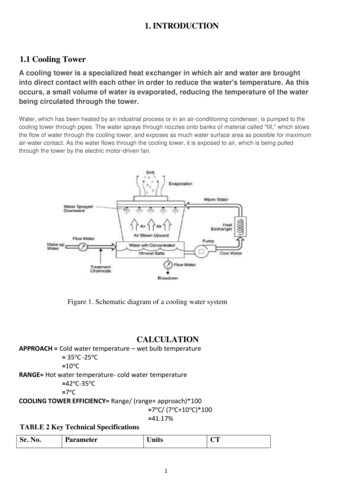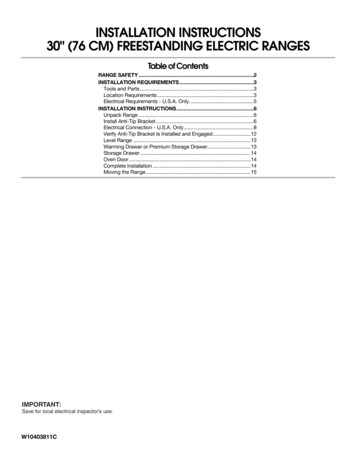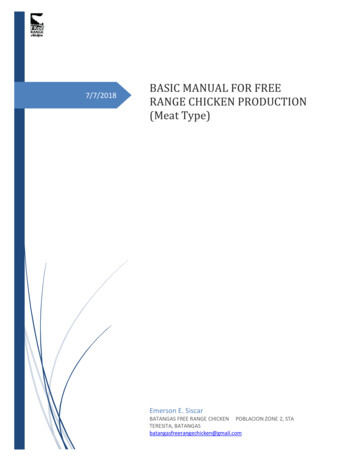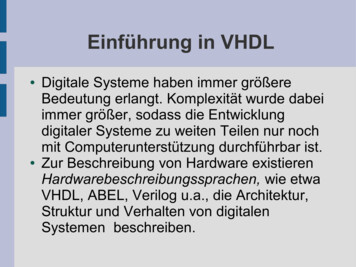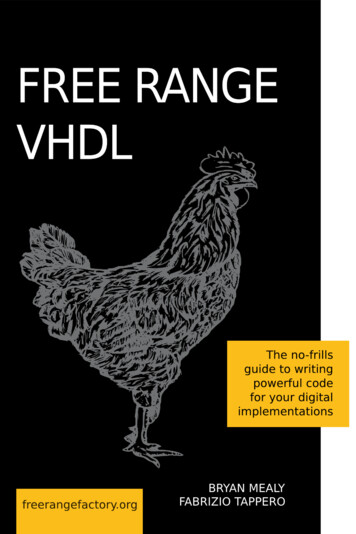
Transcription
Free Range VHDLBryan Mealy, Fabrizio Tappero
Free Range VHDLCopyright 2018 B. Mealy, F. TapperoRelease: 1.21Date: 4 January 2018Book size: 160 mm by 240 mmPages: 194The electronic version of this book can be downloaded free of charge from:http://www.freerangefactory.orgThe authors have taken great care in the preparation of this book, but make no expressedor implied warranty of any kind and assume no responsibility for errors or omissions.No liability is assumed for incidental or consequential damages in connection with orarising out of the use of the information or programs contained in this book.This book is licensed under the Creative Commons Attribution-ShareAlike UnportedLicense, which permits unrestricted use, distribution, adaptation and reproduction inany medium, provided the original work is properly cited. If you build upon this work,you may distribute the resulting work only under the same, similar or a compatiblelicense. To view a copy of this license, 0/Feedback and ContributionWe are more than happy to consider your contribution in improving, extending orcorrecting any part of this book. For any communication or feedback that you mighthave about the content of this book you can contact the authors using the form at thefollowing address:http://www.freerangefactory.orgCover and Artwork by Robert Ash.
To everyone who helped
Table of ContentsAcknowledgmentsvPurpose of this book11 Introduction To VHDL1.1 Golden Rules of VHDL1.2 Tools Needed for VHDL Development5882 VHDL Invariants2.1 Case Sensitivity2.2 White Space2.3 Comments2.4 Parentheses2.5 VHDL Statements2.6 if, case and loop Statements2.7 Identifiers2.8 Reserved Words2.9 VHDL Coding Style111111121213131415153 VHDL Design Units3.1 Entity3.2 VHDL Standard Libraries171822
ii3.33.43.53.6ArchitectureSignal and Variable AssignmentsSummaryExercises232325264 VHDL Programming Paradigm4.1 Concurrent Statements4.2 Signal Assignment Operator “ ”4.3 Concurrent Signal Assignment Statements4.4 Conditional Signal Assignment when4.5 Selected Signal Assignment with select4.6 Process Statement4.7 Summary4.8 Exercises2930333438424647485 Standard Models in VHDL Architectures5.1 Data-flow Style Architecture5.2 Behavioral Style Architecture5.3 Process Statement5.4 Sequential Statements5.4.1Signal Assignment Statement5.4.2if Statement5.4.3case Statement5.5 Caveats Regarding Sequential Statements5.6 Summary5.7 Exercises: Behavioral Modeling51525353555757626667686 VHDL Operators6.1 Logical Operators6.2 Relational Operators6.3 Shift Operator6.4 Other Operators6.5 Concatenation Operator6.6 Modulus and Remainder Operators6.7 Review of Almost Everything Up to Now7172727273747475
iii7 Using VHDL for Sequential Circuits7.1 Simple Storage Elements Using VHDL7.2 Inducing Memory: Data-flow vs. Behavioral Modeling7.3 Important Points7.4 Exercises: Basic Memory Elements77778485868 Finite State Machine Design Using VHDL8.1 VHDL Behavioral Representation of FSMs8.2 One-Hot Encoding for FSMs8.3 Important Points8.4 Exercises: Behavioral Modeling of FSMs89911011061079 Structural Modeling In VHDL9.1 VHDL Modularity with Components9.2 Generic Map9.3 Important Points9.4 Exercises: Structural Modeling11912112913013110 Registers and Register Transfer Level10.1 Important Points10.2 Exercises: Register Transfer Level Circuits13314014011 Data Objects11.1 Types of Data Objects11.2 Data Object Declarations11.3 Variables and Assignment Operator “: ”11.4 Signals vs. Variables11.5 Standard Data Types11.6 User-Defined Types11.7 Commonly Used Types11.8 Integer Types11.9 signed and unsigned Types11.10 std logic Types11.11 Important Points143143144145145147147148148150151154
iv12 Looping Constructs12.1 for and while Loops12.1.1 for Loops12.1.2 while Loops12.1.3 Loop Control: next and exit Statements15515515615815813 Standard Digital Circuits in VHDL13.1 RET D Flip-flop - Behavioral Model13.2 FET D Flip-flop with Active-low Asynchronous Preset Behavioral Model13.3 8-Bit Register with Load Enable - Behavioral Model13.4 Synchronous Up/Down Counter - Behavioral Model13.5 Shift Register with Synchronous Parallel Load - BehavioralModel13.6 8-Bit Comparator - Behavioral Model13.7 BCD to 7-Segment Decoder - Data-Flow Model13.8 4:1 Multiplexer - Behavioral Model13.9 4:1 Multiplexer - Data-Flow Model13.10 Decoder161162Appendix A VHDL Reserved Words169Appendix B Standard VHDL PackagesB.1 IEEE Standard LibrariesB.2 Non-standard Libraries171173173Appendix C VHDL Reference Cards175Appendix D Contributors to This Book181162163163164165165166166167
AcknowledgmentsThe authors would like to thank Christina Jarron for her invaluable contribution to proofreading this book and for her useful suggestions. Specialthanks also to Rob Ash for helping us make the cover of the book distinctive with his original artwork. A massive thank you goes to Keith Knowlesfor his time and effort in reviewing and editing the final draft of this book.Finally, the authors would like to thank all the people who have providedfeedback and suggestions.
Purpose of this bookThe purpose of this book is to provide students and young engineers witha guide to help them develop the skills necessary to be able to use VHDLfor introductory and intermediate level digital design. These skills will alsogive you the ability and the confidence to continue on with VHDL-baseddigital design. In this way, you will also take steps toward developingthe skills required to implement more advanced digital design systems.Although there are many books and on-line tutorials dealing with VHDL,these sources are often troublesome for several reasons. Firstly, much ofthe information regarding VHDL is either needlessly confusing or poorlywritten. Material with these characteristics seems to be written from thestandpoint of someone who is either painfully intelligent or has forgottenthat their audience may be seeing the material for the first time. Secondly,the common approach for most VHDL manuals is to introduce too manytopics and a lot of extraneous information too early. Most of this materialwould best appear later in the presentation. Material presented in thismanner has a tendency to be confusing, is easily forgotten if misunderstoodor simply is never applied. The approach taken by this book is to provideonly what you need to know to quickly get up and running in VHDL.As with all learning, once you have obtained and applied some usefulinformation, it is much easier to build on what you know as opposedto continually adding information that is not directly applicable to the
2subjects at hand.The intent of this book is to present topics to someone familiar with digitallogic design and with some skills in algorithmic programming languagessuch as Java or C. The information presented here is focused on giving asolid knowledge of the approach and function of VHDL. With a logical andintelligent introduction to basic VHDL concepts, you should be able toquickly and efficiently create useful VHDL code. In this way, you will seeVHDL as a valuable design, simulation and test tool rather than anotherbatch of throw-away technical knowledge encountered in some forgottenclass or lab.Lastly, VHDL is an extremely powerful tool. The more you understandas you study and work with VHDL, the more it will enhance your learningexperience independently of your particular area of interest. It is well worthnoting that VHDL and other similar hardware design languages are used tocreate most of the digital integrated circuits found in the various electronicgizmos that overwhelm our modern lives. The concept of using softwareto design hardware that is controlled by software will surely provide youwith endless hours of contemplation. VHDL is a very exciting languageand mastering it will allow you to implement systems capable of handlingand processing in parallel ns-level logic events in a comfortable softwareenvironment.This book was written with the intention of being freely available toeverybody. The formatted electronic version of this book is available fromthe Internet. Any part of this book can be copied, distributed and modifiedin accordance with the conditions of its license.DISCLAIMER: This book quickly takes you down the path towardunderstanding VHDL and writing solid VHDL code. The ideas presentedherein represent the core knowledge you will need to get up and runningwith VHDL. This book in no way presents a complete description of theVHDL language. In an effort to expedite the learning process, some of thefiner details of VHDL have been omitted from this book. Anyone who hasthe time and inclination should feel free to further explore the true depthof the VHDL language. There are many on-line VHDL reference books and
3free tutorials. If you find yourself becoming curious about what this bookis not telling you about VHDL, take a look at some of these references.
1Introduction To VHDLVHDL has a rich and interesting history1 . But since knowing this historyis probably not going to help you write better VHDL code, it will only bebriefly mentioned here. Consulting other, lengthier texts or search engineswill provide more information for those who are interested. Regardingthe VHDL acronym, the V is short for yet another acronym: VHSICor Very High-Speed Integrated Circuit. The HDL stands for HardwareDescription Language. Clearly, the state of technical affairs these days hasdone away with the need for nested acronyms. VHDL is a true computerlanguage with the accompanying set of syntax and usage rules. But, asopposed to higher-level computer languages, VHDL is primarily used todescribe hardware. The tendency for most people familiar with a higherlevel computer language such as C or Java is to view VHDL as just anothercomputer language. This is not altogether a bad approach if such a viewfacilitates the understanding and memorization of the language syntax andstructure. The common mistake made by someone with this approach isto attempt to program in VHDL as they would program a higher-levelcomputer language. Higher-level computer languages are sequential innature; VHDL is not.VHDL was invented to describe hardware and in fact VHDL is a concurrent language. What this means is that, normally, VHDL instructionsare all executed at the same time (concurrently), regardless of the size of1VHDL-Wikipedia: http://en.wikipedia.org/wiki/VHDL
6Chapter 1: Introduction To VHDLyour implementation. Another way of looking at this is that higher-levelcomputer languages are used to describe algorithms (sequential execution)and VHDL is used to describe hardware (parallel execution). This inherentdifference should necessarily encourage you to re-think how you write yourVHDL code. Attempts to write VHDL code with a high-level languagestyle generally result in code that nobody understands. Moreover, thetools used to synthesize2 this type of code have a tendency to generatecircuits that generally do not work correctly and have bugs that are nearlyimpossible to trace. And if the circuit does actually work, it will most likelybe inefficient due to the fact that the resulting hardware was unnecessarilylarge and overly complex. This problem is compounded as the size andcomplexity of your circuits becomes greater.There are two primary purposes for hardware description languages suchas VHDL. First, VHDL can be used to model digital circuits and systems.Although the word “model” is one of those overly used words in engineering,in this context it simply refers to a description of something that presentsa certain level of detail. The nice thing about VHDL is that the levelof detail is unambiguous due to the rich syntax rules associated with it.In other words, VHDL provides everything that is necessary in order todescribe any digital circuit. Likewise, a digital circuit/system is any circuitthat processes or stores digital information. Second, having some type ofcircuit model allows for the subsequent simulation and/or testing of thecircuit. The VHDL model can also be translated into a form that can beused to generate actual working circuits. The VHDL model is magically3interpreted by software tools in such a way as to create actual digitalcircuits in a process known as synthesis.There are other logic languages available to model the behavior of digitalcircuit designs that are easy to use because they provide a graphicalmethod to model circuits. For them, the tendency is to prefer the graphicalapproach because it has such a comfortable learning curve. But, as you caneasily imagine, your growing knowledge of digital concepts is accompanied2Synthesis: the process of interpreting VHDL code and outputting a definition ofthe physical circuit implementation to be programmed on a device such as an FPGA.3It is not really magic. There is actually a well-defined science behind it.
7by the ever-increasing complexity of digital circuits you are dealing with.The act of graphically connecting a bunch of lines on the computer screenquickly becomes tedious. The more intelligent approach to digital circuitdesign is to start with a system that is able to describe exactly how yourdigital circuit works (in other words, modeling it) without having to worryabout the details of connecting large quantities of signal lines. Having aworking knowledge of VHDL will provide you with the tools to modeldigital circuits in a much more intelligent manner.Finally, you will be able to use your VHDL code to create actual functioning circuits. This allows you to implement relatively complex circuitsin a relatively short period of time. The design methodology you will beusing allows you to dedicate more time to designing your circuits and lesstime “constructing” them. The days of placing, wiring and troubleshootingmultiple integrated circuits on a proto-board are gone.VHDL is a very exciting language that can allow the design and implementation of functions capable of processing an enormous amount of databy employing a relatively low-cost and low-power hardware. Moreover,what is really impressive is that, via simple VHDL modules, you canhave direct access to basic ns-level logic events as well as communicateusing a USB port or drive a VGA monitor to visualize graphics of modestcomplexity.Modeling digital circuits with VHDL is a form of modern digital designdistinct from schematic-based approaches. The programmer writes a loosedescription of what the final logic circuit should do and a language compiler,in this case called a synthesizer, attempts to “infer” what the actual finalphysical logic circuit should be. Novice programmers are not always able toconvince the synthesizer to implement something that seems very clear intheir minds. A somehow old-fashioned alternative to a descriptive languagesuch as VHDL is one in which the programmer simply interconnects afinite number of digital blocks that he has pooled from a library in anattempt to reach the same objective. This approach is not only very timeconsuming but also inherently limiting and very error prone.Modern digital design is more about appropriately modeling digitalcircuits and maintaining a quality description of the circuit. All that is left
8Chapter 1: Introduction To VHDLnow is to learn how to properly use VHDL to describe what you want toimplement.1.1 Golden Rules of VHDLBefore you start, here are a couple of points that you should never forgetwhen working with VHDL.VHDL is a hardware-design language. Although most people haveprobably already been exposed to some type of higher-level computerlanguage, these skills are only indirectly applicable to VHDL. When youare working with VHDL, you are not programming, you are “designinghardware”. Your VHDL code should reflect this fact. What does this mean?It means that unless you are inside certain constructs, your code lines willbe executed almost all at once. If your VHDL code appears too similar tocode of a higher-level computer language, it is probably bad VHDL code.This is vitally important.Have a general concept of what your hardware should look like.Although VHDL is vastly powerful, if you do not understand basic digitalconstructs, you will probably be unable to generate efficient digital circuits.Digital design is similar to higher-level language programming in that eventhe most complicated programming at any level can be broken down intosome simple programming constructs. There is a strong analogy to digitaldesign in that even the most complicated digital circuits can be describedin terms of basic digital constructs. In other words, if you are not able toroughly envision the digital circuit you are trying to model in terms ofbasic digital circuits, you will probably misuse VHDL, thus angering theVHDL gods. VHDL is cool, but it is not as magical as it initially appearsto be.1.2 Tools Needed for VHDL DevelopmentVHDL is a language used to implement hardware which will run othersoftware (for example C). A Field Programmable Gate Array (FPGA)is probably the most common device that you can use for your VHDL
1.2 Tools Needed for VHDL Development9implementations. If you want to do VHDL coding for FPGAs you will haveto play within the rules that current major FPGA manufacturers havedrawn up to help you (rules which also ensure their continued existence inthe market).The successful implementation of a VHDL-based system roughly callsfor the following steps: VHDL code writing, compiling, simulation andsynthesis. All major FPGA manufacturers have a set of software andhardware tools that you can use to perform the mentioned steps. Most ofthese software tools are free of charge but are not open-source. Nevertheless,the same tools follow a license scheme, whereby paying a certain amountof money allows you to take advantage of sophisticated software featuresor get your hands on proprietary libraries with lots of components (e.g. a32-bit processor) that you can easily include in your own project.If your have no interest in proprietary libraries you can use open-sourcesolutions (e.g. GHDL4 or BOOT5 ) which will allow you to compile andsimulate your VHDL code using the open-source tool gcc6 . At the timeof writing, no open-source solution is available for the synthesis process.However synthesis can be accomplished using a free-license version of anymajor FPGA manufacturer’s software tool (e.g. Xilinx Vivado).Thanks to the open-source community, you can write, compile andsimulate VHDL systems using excellent open-source solutions. This bookwill show you how to get up and running with the VHDL language. Forfurther tasks such as synthesis and upload of your code into an FPGA, thefree of charge Xilinx Vivado7 or the Altera equivalent tool Quartus, canbe employed.4VHDL simulator GHDL: http://ghdl.free.frVHDL software tool BOOT: http://www.freerangefactory.org6Multi-language open-source compiler GCC: http://gcc.gnu.org7Xilinx Vivado: o.html5
2VHDL InvariantsThere are several features of VHDL that you should know before movingforward. Although it is rarely a good idea for people to memorize anything,you should memorize the basic concepts presented in this section. Thisshould help eliminate some of the drudgery involved in learning a newprogramming language and lay the foundation that will enable you tocreate visually pleasing and good VHDL source code.2.1 Case SensitivityVHDL is not case sensitive. This means that the two statements shownin Listing 2.1 have the exact same meaning (don’t worry about what thestatement actually means though). Keep in mind that Listing 2.1 shows anexample of VHDL case sensitivity and not good VHDL coding practices.Listing 2.1: An example of VHDL case insensitivity.Dout A and B;doUt a AnD b;2.2 White SpaceVHDL is not sensitive to white space (spaces and tabs) in the sourcedocument. The two statements in Listing 2.2 have the exact same meaning.Once again, Listing 2.2 is not an example of good VHDL coding style.Note that Listing 2.2 once again indicates that VHDL is not case sensitive.Listing 2.2: An example showing VHDL’s indifference to white space.nQ In a or In b;nQ in a ORin b;
12Chapter 2: VHDL Invariants2.3 CommentsComments in VHDL begin with the symbol “--” (two consecutive dashes).The VHDL synthesizer ignores anything after the two dashes and up tothe end of the line in which the dashes appear. Listing 2.3 shows two typesof commenting styles. Unfortunately, there are no block-style comments(comments that span multiple lines but do not require comment marks onevery line) available in VHDL.Listing 2.3: Two typical uses of comments.-- This next section of code is used to blah-blah-- This type of comment is the best fake for block-style commenting.PS reg NS reg; -- Assign next state value to present stateAppropriate use of comments increases both the readability and theunderstandability of VHDL code. The general rule is to comment anyline or section of code that may not be clear to a reader of your codebesides yourself. The only inappropriate use of a comment is to statesomething that is patently obvious. It is hard to imagine code that hastoo few comments so don’t be shy: use lots of comments. Research hasshown that using lots of appropriate comments is actually a sign of highintelligence.2.4 ParenthesesVHDL is relatively lax on its requirement for using parentheses. Like othercomputer languages, there are a few precedence rules associated with thevarious operators in the VHDL language. Though it is possible to learnall these rules and write clever VHDL source code that will ensure thereaders of your code are left scratching their heads, a better idea is topractice liberal use of parentheses to ensure the human reader of yoursource code understands the purpose of the code. Once again, the twostatements appearing in Listing 2.4 have the same meaning. Note thatextra white space has been added along with the parentheses to make thelower statement clearer.
2.5 VHDL Statements13Listing 2.4: Example of parentheses that can improve clarity.if x '0' and y '0' or z '1' thenblah; -- some useful statementblah; -- some useful statementend if;if ( ((x '0') and (y '0')) or (z '1') ) thenblah; -- some useful statementblah; -- some useful statementend if;2.5 VHDL StatementsSimilar to other algorithmic computer languages, every VHDL statementis terminated with a semicolon. This fact helps when attempting to remove compiling errors from your code since semicolons are often omittedduring initial coding. The main challenge then is to know what constitutesa VHDL statement in order to know when to include semicolons. TheVHDL synthesizer is not as forgiving as other languages when superfluoussemicolons are placed in the source code.2.6 if, case and loop StatementsAs you will soon find out, the VHDL language contains if, case andloop statements. A common source of frustration that occurs when learning VHDL are the classic mistakes involving these statements. Alwaysremember the rules stated below when writing or debugging your VHDLcode and you will save yourself a lot of time. Make a note of this section asone you may want to read again once you have had a formal introductionto these particular statements. Every if statement has a corresponding then component Each if statement is terminated with an end if; If you need to use an else if construct, the VHDL version is elsif Each case statement is terminated with an end case; Each loop statement has a corresponding end loop; statementIn general, you should not worry too much about memorizing code syntaxas chances are you will use an editor sophisticated enough to have code
14Chapter 2: VHDL Invariantssnippets (namely Gedit1 ). A good programmer distinguishes himself byother means than perfectly remembering code syntax.2.7 IdentifiersAn identifier refers to the name given to various items in VHDL. Examplesof identifiers in higher-level languages include variable names and functionnames. Examples of identifiers in VHDL include variable names, signalnames and port names (all of which will be discussed soon). Listed beloware the hard and soft rules (i.e. you must follow them or you should followthem), regarding VHDL identifiers. Identifiers should be self-describing. In other words, the text you applyto identifiers should provide information as to the use and purpose ofthe item the identifier represents. Identifiers can be as long as you want (contain many characters). Shorternames make for better reading code, but longer names present moreinformation. It is up to the programmer to choose a reasonable identifierlength. Identifiers can only contain a combination of letters (A-Z and a-z),digits (0-9) and the underscore character (“ ”). Identifiers must start with an alphabetic character. Identifiers must not end with an underscore and must never have twoconsecutive underscores. The best identifier for a function that calculates the position of the Earthis CalcEarthPosition or calc earth position. Try to be consistent. The best identifier for a variable that stores the age of your car isAgeMyCar or age my car. Again, try to be consistent.Remember, intelligent choices for identifiers make your VHDL code morereadable, understandable and more impressive to coworkers, superiors,family and friends. A few examples of both good and bad choices foridentifier names appear in Listing 2.5 and in Listing 2.6.1Gedit, the official Linux GNOME text editor: http://projects.gnome.org/gedit
2.8 Reserved Words15Listing 2.5: Valid identifiers.Listing 2.6: Invalid identifiers.data bus--descriptive nameWE--classic write enablediv flag--real winnerport A--provides some infoin bus--input busclk--classic clockclk inclk outmem read data----3Bus val -DDD-mid num -last val-str val -in-@# %%-it sucks -Big vAlUe-pa-sim-val -DDE SUX --begins with a numbernot self commentingillegal characterconsec. underscoresends with underscoreuses VHDL reserved wordtotal garbagetry to avoidvalid but uglypossibly lacks meaningillegal character(dash)no comment2.8 Reserved WordsThere is a list of words that have been assigned special meaning by theVHDL language. These special words, usually referred to as reserved words,cannot be used as identifiers when writing VHDL code. A partial list ofreserved words that you may be inclined to use appears in Listing 2.7. Acomplete list of reserved words appears in the Appendix. Notably missingfrom Listing 2.7 are standard operator names such as AND, OR, XOR,etc.Listing 2.7: A short list of VHDL reserved innextrangetowhileblockfileisnullremtypewith2.9 VHDL Coding StyleCoding style refers to the appearance of the VHDL source code. Obviously,the freedom provided by case insensitivity, indifference to white spaceand lax rules on parentheses creates a coding anarchy. The emphasis incoding style is therefore placed on readability. Unfortunately, the levelof readability of any document, particularly coding text, is subjective.Writing VHDL code is similar to writing code in other computer languagessuch as C and Java where you have the ability to make the document morereadable without changing the functioning of the code. This is primarilydone by indenting certain portions of the program, using self-describing
16Chapter 2: VHDL Invariantsidentifiers and providing proper comments when and where necessary.Instead of stating here a bunch of rules for you to follow as to how yourcode should look, you should instead strive to simply make your sourcecode readable. Listed below are a few thoughts on what makes readablesource code. Chances are that if your VHDL source code is readable to you, it willbe readable to others who may need to peruse your document. Theseother people may include someone who is helping you get the codeworking properly, someone who is assigning a grade to your code, orsomeone who signs your paycheck at the end of the day. These arethe people you want to please. These people are probably very busyand more than willing to make a superficial glance at your code. Nicelooking code will slant such subjectivity in your favor. If in doubt, your VHDL source code should be modeled after someother VHDL document that you find organized and readable. Any codeyou look at that is written down somewhere is most likely written bysomeone with more VHDL experience than a beginner such as yourself.Emulate the good parts of their style while on the path to creating aneven more readable style. Adopting a good coding style helps you write code without mistakes.As with other compilers you have experience with, you will find thatthe VHDL compiler does a great job of knowing a document has anerror but a marginal job at telling you where or what the error is.Using a consistent coding style enables you to find errors both beforecompilation and after the compiler has found an error. A properly formatted document explicitly presents information aboutyour design that would not otherwise be readily apparent. This is particularly true when using proper indentation and sufficient comments.
3VHDL Design UnitsThe “black-box” approach to any type of design implies a hierarchicalstructure in which varying amounts of detail are available at each of thedifferent levels of the hierarchy. In the black-box approach, units of actionwhich share a similar purpose are grouped together and abstracted to ahigher level. Once this is done, the module is referred to by its inherentlymore simple black-box representation rather than by the details of thecircuitry that actually performs that functionality. This approach has twomain advantages. First, it simplifies the design from a systems standpoint.Examining a circuit diagram containing appropriately named black boxes ismuch more understandable than stari
with VHDL. This book in no way presents a complete description of the VHDL language. In an e ort to expedite the learning process, some of the ner details of VHDL have been omitted from this book. Anyone who has the time and inclination should feel free to further explore the true depth of the VHDL l
